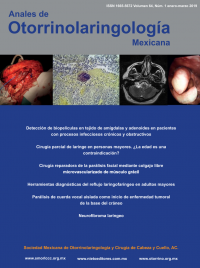Isolated vocal cord palsy as skull base tumor debut.
An Orl Mex. 2019 enero-marzo;64(1):25-32.

Patricia Corriols-Noval,1 Carmelo Morales-Angulo2
1 Residente del Servicio de Otorrinolaringología.
2 Jefe del Servicio de Otorrinolaringología.
Hospital Universitario Marqués de Valdecilla, Santander, España.
Resumen
OBJETIVO: Conocer los tumores de la base del cráneo que pueden causar, como síntoma inicial, una parálisis de cuerda vocal aislada.
MATERIAL Y MÉTODO: Estudio retrospectivo, observacional, descriptivo y transversal de las historias clínicas de los pacientes con parálisis de cuerda vocal aislada del servicio de Otorrinolaringología del Hospital Universitario Marqués de Valdecilla, Santander, España, del 1 de enero de 2007 al 31 de enero de 2018, cuya causa fue un tumor de la base craneal. Las variables analizadas fueron: edad, tipo histológico, técnica diagnóstica y tratamiento.
RESULTADOS: Se objetivaron tres casos con edades entre 39 y 75 años, en los que el paraganglioma yugulotimpánico fue el tumor causante de la parálisis de cuerda vocal. La tomografía computada fue la primera técnica de imagen realizada, seguida de la resonancia magnética. Se decidió exéresis quirúrgica en uno de los casos, radiocirugía en otro y seguimiento y control evolutivo del tercero debido al alto riesgo anestésico del paciente.
CONCLUSIONES: Aunque infrecuente, una parálisis de cuerda vocal aislada puede constituir el inicio de un tumor de la base del cráneo, el paraganglioma es el tumor más habitual. La resonancia magnética es la prueba de imagen de elección, por su mayor sensibilidad para evaluar lesiones de tejidos blandos en el trayecto del nervio vago y en la base del cráneo.
PALABRAS CLAVE: Parálisis de cuerda vocal; base del cráneo; paraganglioma.
Abstract
OBJECTIVE: To know the skull base tumors that can cause isolated vocal cord palsy as initial sign.
MATERIAL AND METHOD: A retrospective, observational, descriptive and cross-sectional study of clinical histories of all patients with a unilateral vocal cord palsy who presented to Hospital Universitario Marqués de Valdecilla, Santander, Spain, from January 1st 2007 to January 31st 2018, which cause was a tumor of skull base. We took into consideration the following variables: age, tumoral histology, diagnostic imaging test and treatment.
RESULTS: A total of 3 cases were detected, with an age range of 39 to 75 years, jugulotympanic paraganglioma was the tumor diagnosed in all the patients. In all, computed tomography was the first diagnostic imaging test performed, followed by magnetic resonance. One of our patient was undergone to surgical treatment, another was undergone to radiosurgery and in the third one it was decided to follow up due to high anesthesia risk.
CONCLUSION: Although rarely, isolated vocal cord palsy could be a skull base tumor debut, being paraganglioma the most common neoplasm. Magnetic resonance should be chosen as the first-line imaging test, by its higher sensitivity to characterize soft tissue abnormalities along the vagal nerve tract and skull base.
KEYWORDS: Vocal cord paralysis; Skull base; Paraganglioma.

